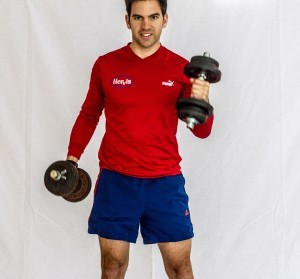HIIT training: how to train better with less time
I love HIIT training .
It’s exhausting, but extremely effective .
In this article you will find out what it is exactly and how you can integrate it into your training.
What is HIIT training?
You could also call it training with the hammer .
No, kidding aside .
HIIT means something like High Intensity Interval Training , which means High Intensity Interval Training in German. So it is enough to simply say HIIT, the word training is already included in this abbreviation.

Interval training means that you combine these high-intensity training sections with much easier training sections for recovery . The intense phases last between 15 and 60 seconds n, the recovery phase in low intensity up to three times as long . Then you start again.High-intensity means that you train at around 90 percent of your maximum heart rate . (If you are a beginner, then less). To put it simply: You should get your heart rate up a lot so that your breathing rate is also greatly increased and normal conversations are no longer possible .
And with that most of it is said.
Sounds easy , or?
In principle it is. But here some more information .
Since these are high-intensity training units, beginners should be particularly careful .
A check at the doctor (pay attention to my advice when training) definitely can’t hurt. He should then give you the clearance to exercise (with maximum heart rate).
HIIT units normally only last between 10 and 30 minutes .
And are still more effective than simple moderate endurance training – even if you do your normal cardio training for twice the time. However, you should only do HIIT 2-3 times a week . Simply to give your body some rest. In addition, other training sessions (e.g. strength training or moderate cardio training) can be on the plan.
Why is HIIT so effective?

Cool right? You walk a oxygen debt . That means your body works in the anaerobic area : The oxygen supply is not sufficient to maintain the performance permanently and therefore your oxygen balance in the body must then be balanced again after the unit is brought. This in turn means that you take advantage of the afterburn effect with HIIT . The afterburn effect lets you increase your basal metabolic rate a little after training and also burns mainly body fat.
You can also boost your metabolism with HIIT . This is especially important when losing weight or fat loss, because your body quickly goes into energy-saving mode due to the ongoing calorie deficit, to protect its fat reserves . HIIT counteracts this.
Of course only together with a balanced diet and a calorie deficit.
But even if you want to build muscle, HIIT makes sense because it boosts your anabolic (building) hormone balance (e.g. testosterone).
In the meantime, many studies have been carried out that prove the benefits of HIIT . I have listed some of the best for you here:
- Study 1
This Study from 1994 is one of the first to proven the effectiveness of HIIT . 27 test persons were divided into two groups. One group did a 15-week HIIT program, the other group a 20-week normal cardio program on the ergometer. The fat breakdown in the subcutaneous fat tissue was nine times as high with HIIT as with normal training! - Study 2
In This study from 2007 showed that already after two weeks of HIIT (a total of 7 training units were completed) the capacity of the muscles and the body as a whole to process fatty acids during exercise increased. In other words: To reduce fat more effectively or to use it for performance (muscle activity). - Study 3
In this study from 2012, the research team was able to prove that HIIT performed on an ergometer for 12 weeks (20 minute units with alternating 8 seconds of sprints and 12 seconds of recovery) the maximum oxygen uptake – and thus the endurance capacity – significantly increased . It was also shown that the training group, in contrast to the control group, had lost an average of 2 kilograms of body fat – without changing their eating habits. In addition, the resting heart rate also decreased in the training group. - Study 4
This study from 2013 cited many studies that demonstrated the positive effects of HIIT and analyzed and derived from it our own circuit training – the Scientific 7-Minute Workout. Incidentally, this circuit was my entry point into high-intensity interval training.

The benefits of HIIT
Let me summarize the benefits for you:
- You need less time than for normal training.
- You use the afterburn effect .
- You burn more fat than with moderate endurance training.
- You increase your maximum oxygen uptake and thus your performance as well.
- If you use strengthening exercises without equipment, you can do the training anywhere.
- You promote the release of hormones that positively boost your metabolism.
- You lower blood sugar, insulin and blood fat levels and increase your insulin sensitivity.
These are a lot of good reasons to give HIIT a try right?
HIIT in practice
You now know what HIIT means and what is behind it.
Now I will teach you how you can actually incorporate HIIT into your training and which methods are available.
At the end, you will get the link to my HIIT workouts that I have already put together for you.
Methods
One of the first to implement HIIT was Dr. Izumi Tabata from Japan. The Tabata method is still popular and known today. It consists of 20 seconds of high-intensity exercise (e.g. sprint), 10 seconds of recovery (e.g. running slowly) with a total of 8 repetitions. In total, you only need 4 minutes for a Tabata training (without warming up). However, as an advanced user, you can then take a break from one to several minutes and add the same thing – or several times.

The Little Method includes a high-intensity interval of 60 seconds followed by 75 seconds of low intensity. A total of 12 repetitions and thus 27 minutes of training (without warm-up) are on the program. The Turbulence method combines strength – and cardio training. After a warm-up, you start with a strengthening exercise that provokes a muscle growth stimulus (i.e. a maximum of 8 repetitions with correspondingly high weight and slow, controlled execution) – for example with dumbbells or barbells, or even a difficult bodyweight training exercise such as Pistols, One -Hand push-ups or handstand push-ups. Then you do a high-intensity cardio exercise for one minute, for example, burpees or mountain climbers. You then repeat this until you have reached 30 minutes. Breaks are to be set individually.
The Wingate protocol includes 4-6 intervals, each with 30 seconds of high-intensity exercise and 1 to 2 minutes of recovery. Either run or strengthening exercises without equipment can be used.
There are other methods like the Peter Coe Regimen, the Challenge Method, the 50/10 HIIT, the Gibala Regimen, the Timmons Regimen, etc. What they all have in common is that high-intensity stress phases are combined with recovery phases of low-intensity alternate. The Scientific 7-Minute Workout made it into the New York Times and is also a way to implement HIIT. There are 12 different exercises with your own body weight. You perform each exercise for 30 seconds followed by a 10-second recovery phase.
How to start with HIIT as a beginner
As already mentioned at the beginning: Slowly approach!
And have your doctor issue you the free ticket. Namely, that you are allowed to exercise or reach your maximum heart rate.
Then you get started as follows:

Week 1-3 Warm up before your training session for at least 5 minutes to prevent injuries and improve your performance. You can do this with easy running, simple strengthening exercises without equipment or the like. Even after the intensive training session, it makes sense to run a little or to walk and then do a few stretching exercises.
-
- 20 seconds sprint + 60 seconds break = 1 sentence
- 10 sentences
- 2 x per week
- Week 4-6
- 20 seconds sprint + 50 seconds break = 1 sentence
- 10 sentences
- 3 times a week
- Week 7-9
- 20 seconds sprint + 40 seconds break = 1 sentence
- 12 sentences
- 3 times a week
- Week 10-12
- 20 seconds sprint + 40 seconds break = 1 sentence
- 15 sentences
- 3 times a week
If you’ve pulled it off: Congratulations! You are no longer a beginner.
How you can benefit from HIIT as a trained athlete by the way: You can also replace the sprint with other exercises. A simple example: walking at the stand (so-called high knees). If you then do the recovery with loose high knees (just lift your feet a little, knees don’t go up), you can even do the whole workout at home.
If you already have training experience, you can get started a little more intensively.
But the following also applies here: You should consult your doctor and have them confirm that you are exerting yourself – i.e. reaching your maximum heart rate – may.
If you have not yet incorporated HIIT into your training, it can give you a real boost.
in terms of fat loss, muscle building and performance
How to get started:
- Decide on a method that you would like to try out (Tabata, circle, challenge, etc.)
- Then choose the exercises with which you want to carry out the method (sprints, riding an ergometer, exercises with your own bodyweight, etc.). Here you can also incorporate sport-specific exercises (e.g. jumps to the block if you are a volleyball player, etc.)
- Incorporate the HIIT workout 2-3 times a week into your training.

Here please: Would you like a specific example?
Assuming you have chosen the Tabata method
Week 1
- Build a Tabata circuit (20 seconds of sprinting, 10 seconds of relaxation with easy running or walking and repeating the whole 8 times) into your training
- 2 times a week
- Ideally within another unit that you are already doing
- Please do not use the Tabata circle as a warm-up, but make sure that you are warmed up beforehand. Otherwise, you will firstly increase your susceptibility to injury and secondly reduce your performance.
Week 2-4
- Build your own Tabata training units into your training plan twice a week.
- They look like this:
- 8 x (20 seconds of sprinting + 10 seconds of relaxation)
- One minute break
- 8 x (20 seconds of sprinting + 10 seconds of relaxation)
From week 5
- You can already incorporate 3 Tabata units into your training and/or
- instead of two runs also carry out three runs and
- try other exercises instead of sprints, etc.
If you are looking for a challenge and have already mastered exercises with your own bodyweight technically well, you can also try Freeletics. By the way, Freeletics corresponds most closely to the Challenge method. I have also built HIIT workouts into my training plans.
HIIT workouts that you can do right now
I promised you at the beginning of the article that I would also provide you with a few ready-made workouts with instructions. Et voilà – here they are:
Conclusion
HIIT is a training method that I recommend to everyone.
And it is enough to call it HIIT, HIIT training would be doubled, as already mentioned.
It is exhausting, but the advantages (increased fat loss and increased performance, less time required, etc.) definitely outweigh it. Exertion can also be fun.
Sure, beginners should first slowly approach the high intensities. But the cool thing is that you have results after two weeks.
